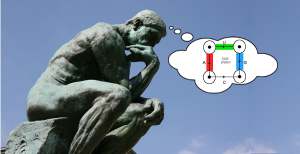 I presented a paper in the session on “Physics and Logic.” organised by Bob Coecke.
I presented a paper in the session on “Physics and Logic.” organised by Bob Coecke.
Theory of Forms
A reconstruction of ancient metaphysics applied to the logical foundations of modern physics
Keywords: Periodic table of subatomic particles, Geometric Algebra, Stoic Logic, operational calculus, sub-quarks.
Abstract
The problem tackled in this work is to develop from purely rational considerations the foundations and ontology of forms universally applicable to any self-managed autonomous system. The physics universe is a special case of such a system. The approach is fundamentally a priorist and so free of empirical or axiomatically determined structures. Key aspects of the approach are developed from a reconstruction of Stoic natural philosophy and logic.
Leibniz famously introduced a new dimension into this ancient problematic, notably that of developing a theory of the forms of nature in terms of a “geometry without number”. Nowadays we see that there are two modern geometric traditions, one analytic (Analytic Geometry [AG] generalized from linear analysis) and the other synthetic (Geometric Algebra [GA]). GA arises from the exterior and geometric products of Grassmann developed further by Cayley and Hamilton and in modern times by David Hestenes. Hestenes and others claim that GA is the fulfillment of Leibniz’s dream. GA certainly provides the great simplifications that Leibniz demanded and is free of coordinates. But it is not free of number, nor does it provide an algebra based on “a few letters” that would describe the forms of nature both in the biological and non-biological worlds.
This work is presented as a true fulfillment of Leibniz’s dream by developing a more fundamental version of GA which is truly a “geometry without number” and integrating it into a radical reconstruction of Stoic logic and physics.
Since the universe we live in can be considered as a totally autonomous self-managed system, the resulting theory should be applicable to developing the foundations of physics from a fundamental quantum perspective. This turns out to be possible and, unlike String Theory, leads to practical results. One result is the development of a sort of “Periodic Table” of subatomic particles that extends beyond the already known constituents. The theory predicts a lower “sub-quark” level as the primary substratum and. Unlike the Standard Model” does not require quarks with fractional charge. Everything is presented in terms of geometric semantics including such allusive notions as “colour charge.”
The end result can best be understood as “doing a Heaviside” by presenting quantum mechanics in a time independent “non-diachronic” form. This approach is considered as the complementary opposite of the present day standard approach. The tools of Laplace formalize Heaviside’s approach and works well for DEs but not for partial DEs. To universally handle the latter, a more powerful formalism is required. The elements of that approach can be found in Stoic logic once properly reconstructed and explained.
Full paper and book in preperation
Database
The prototype database for “the periodic table of subatomic particles” can be found here. on this website here..
Power Point Presentation
